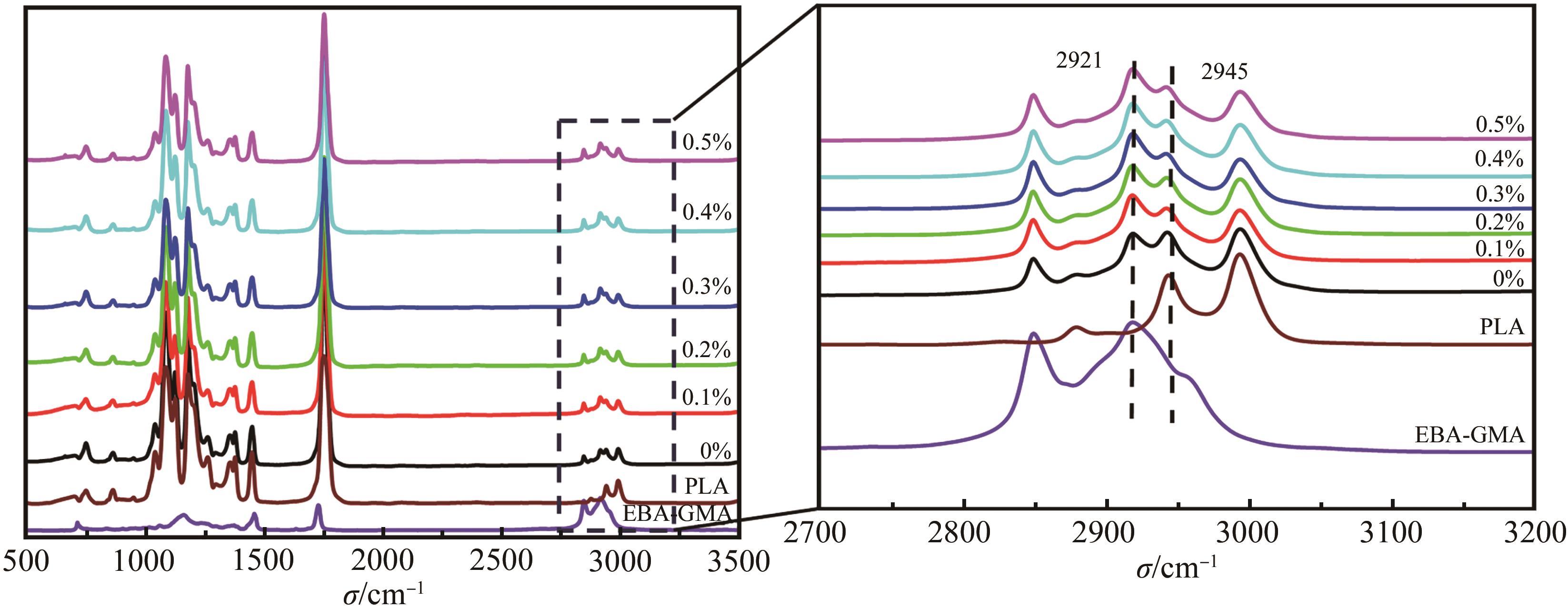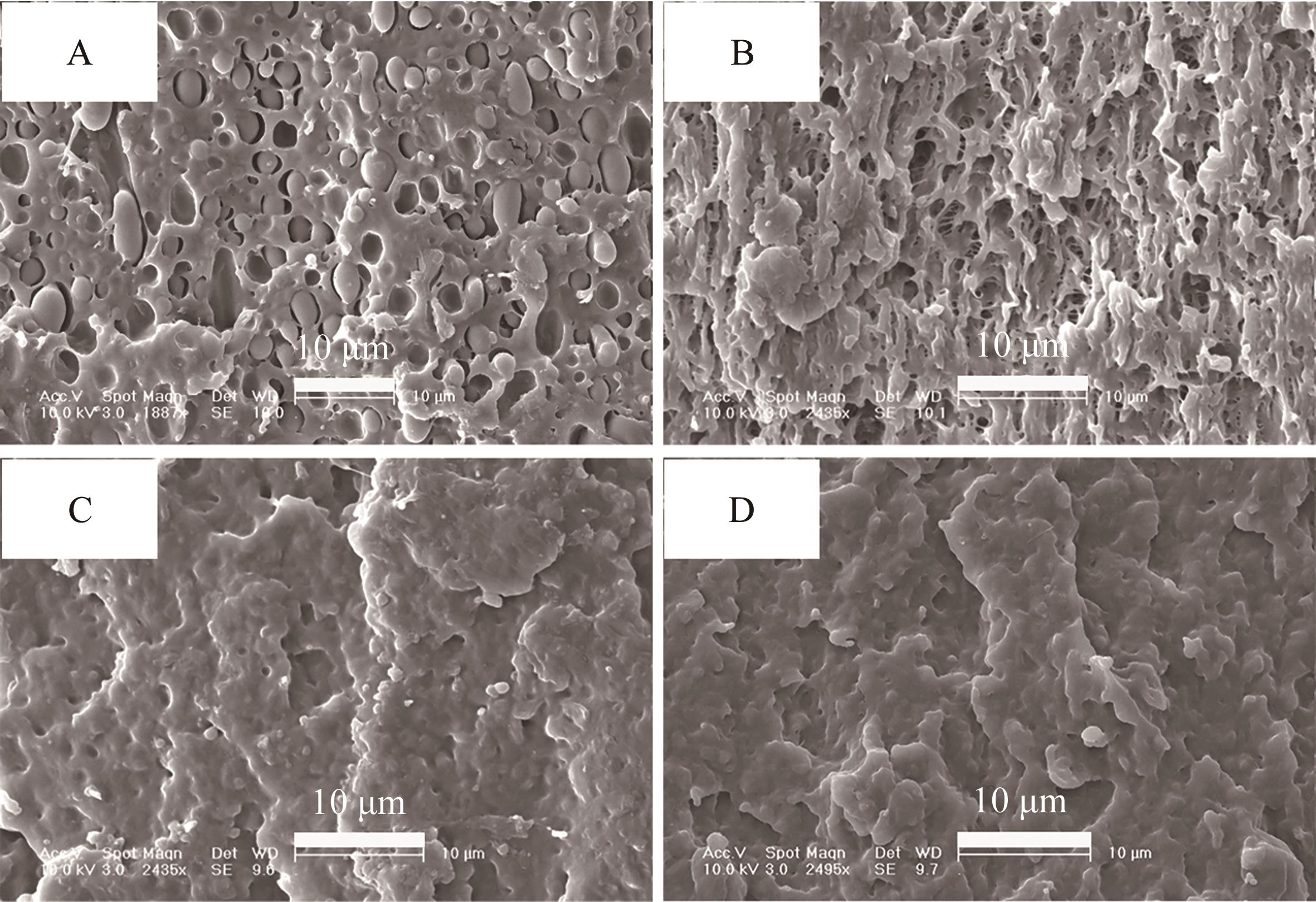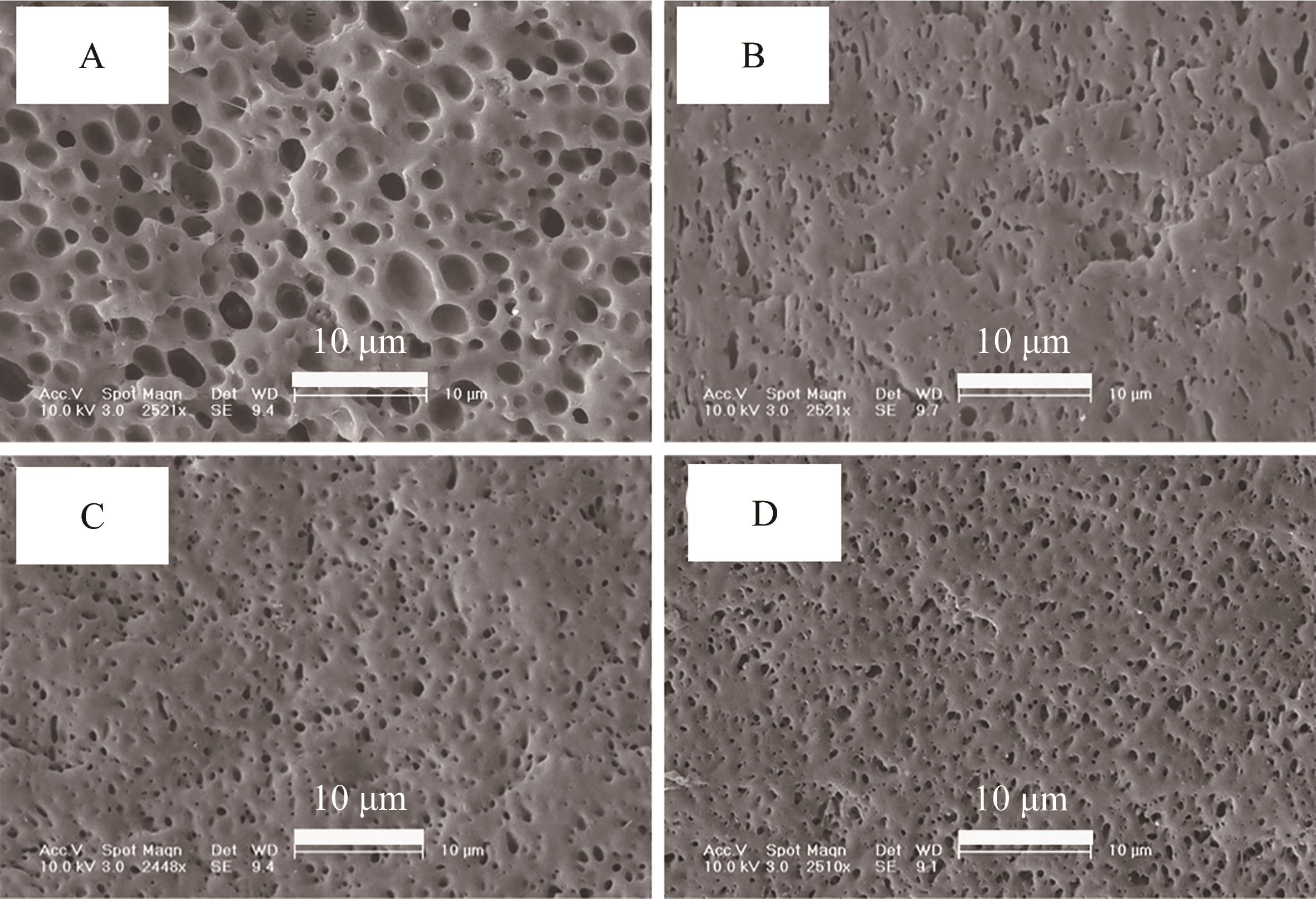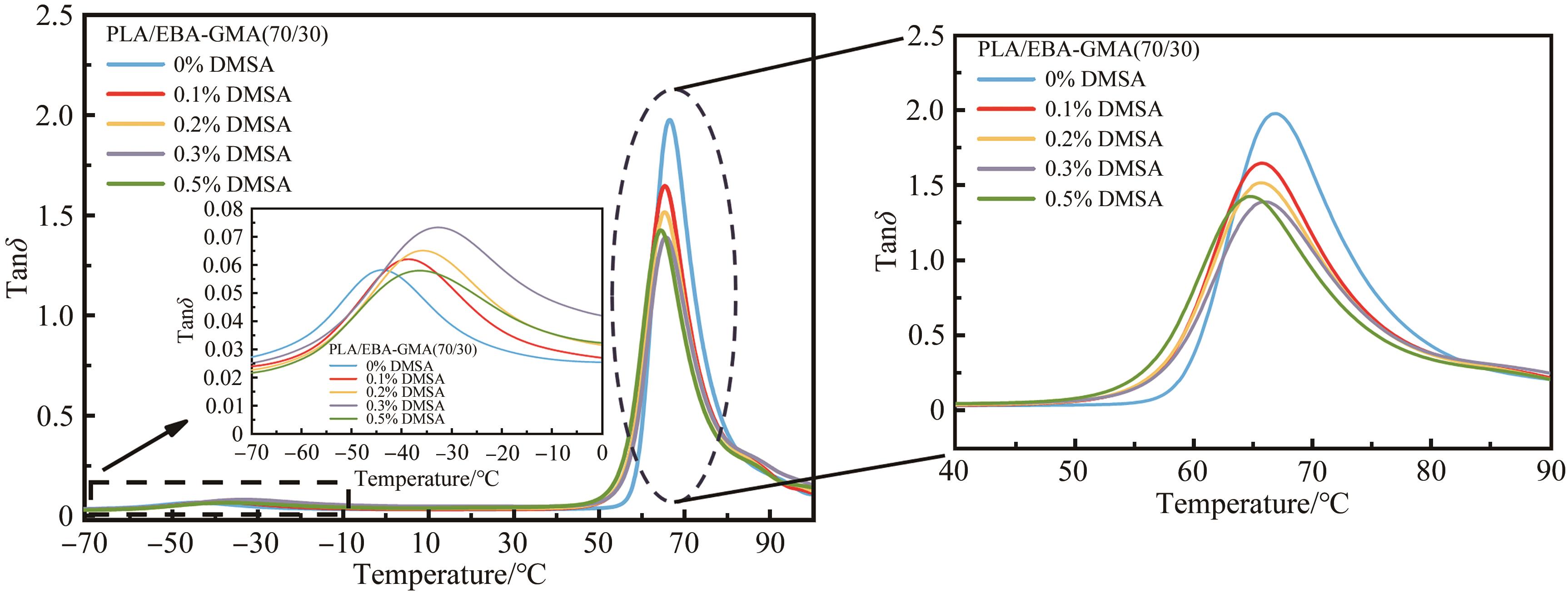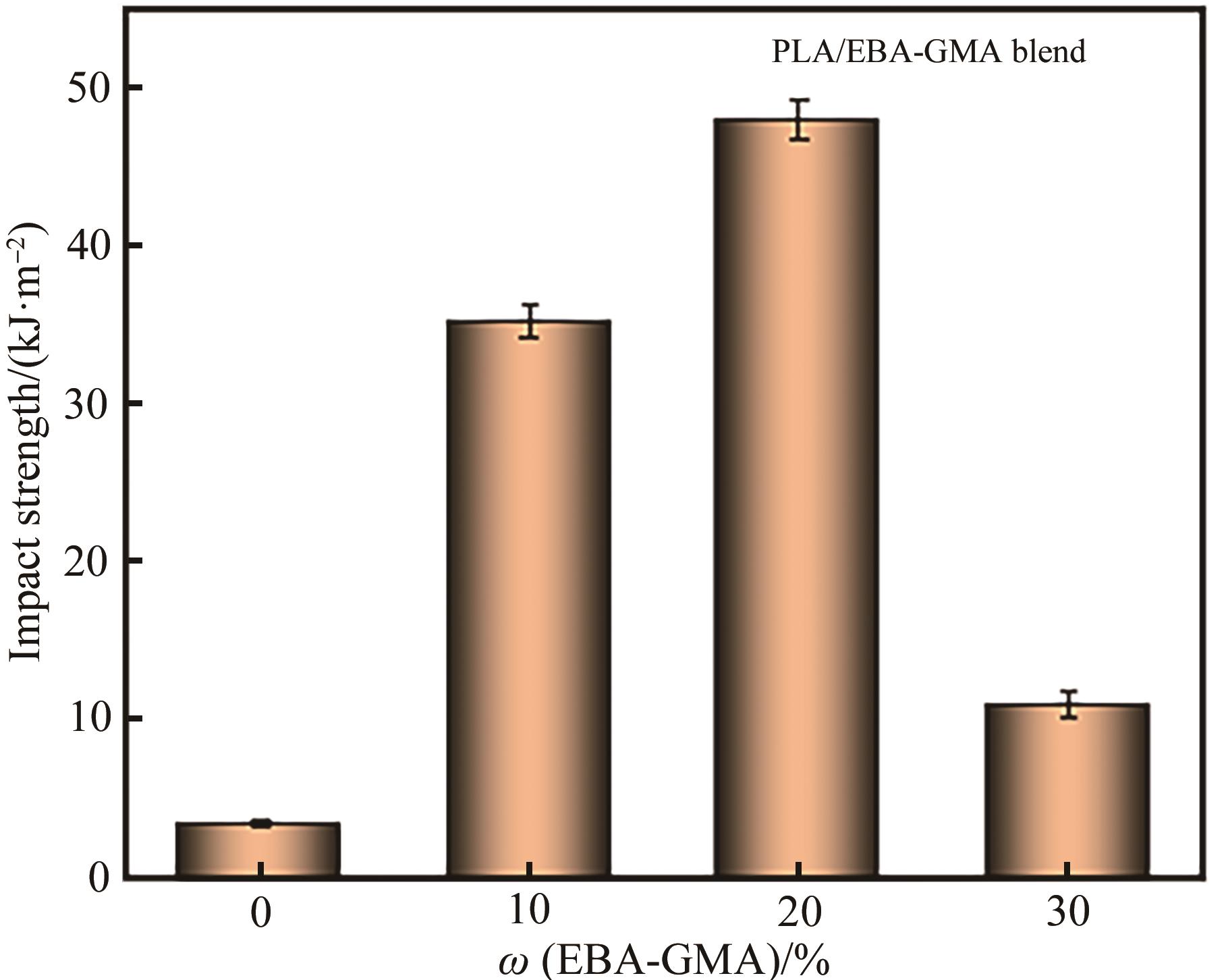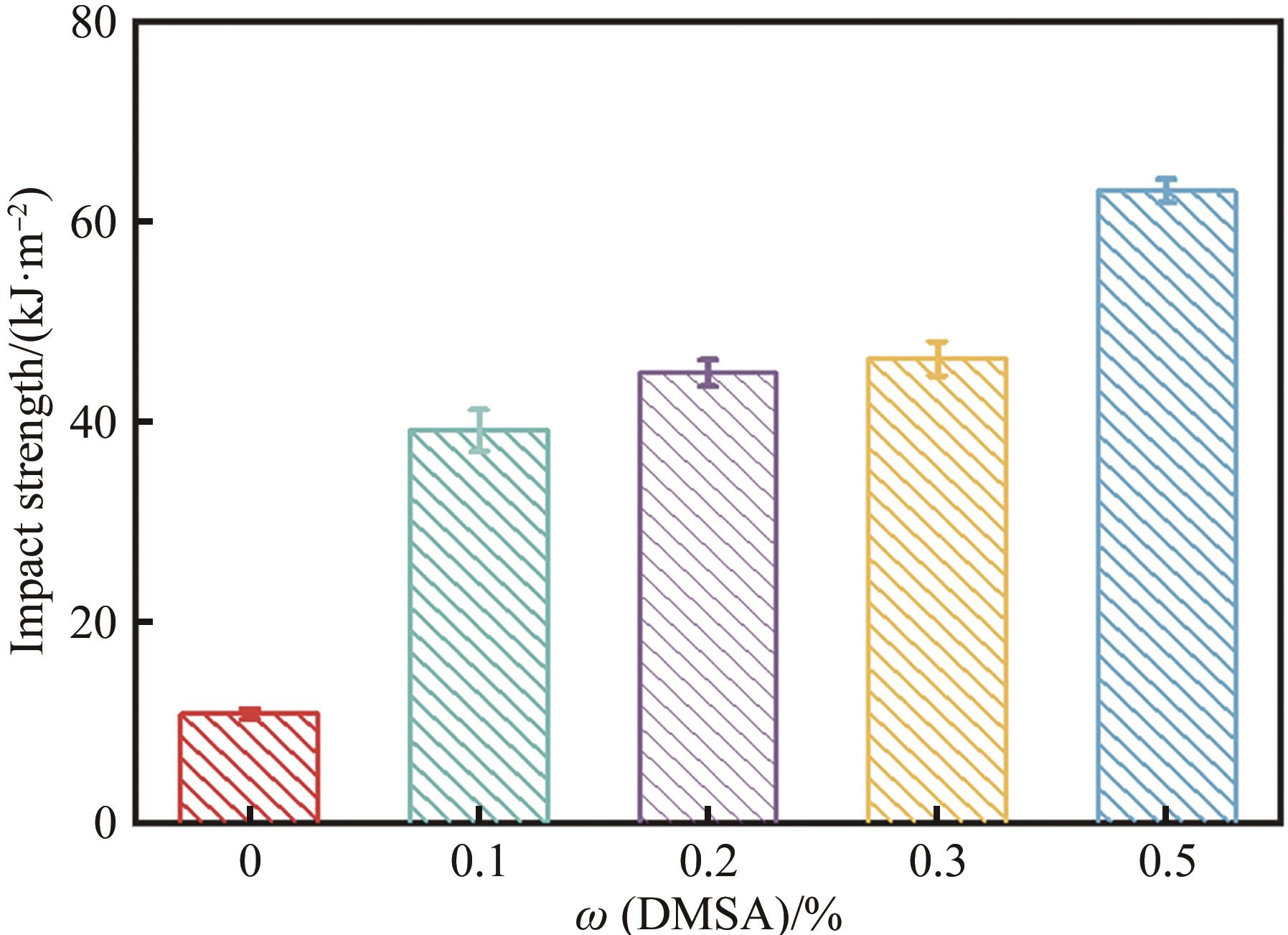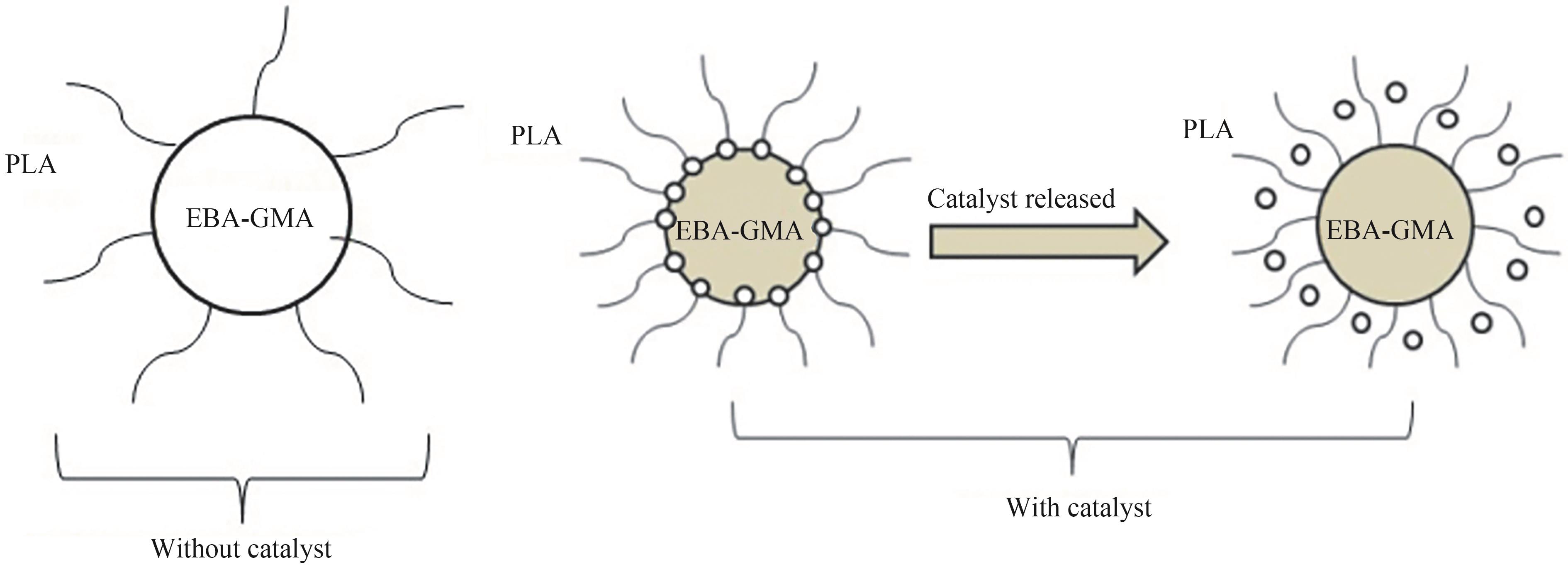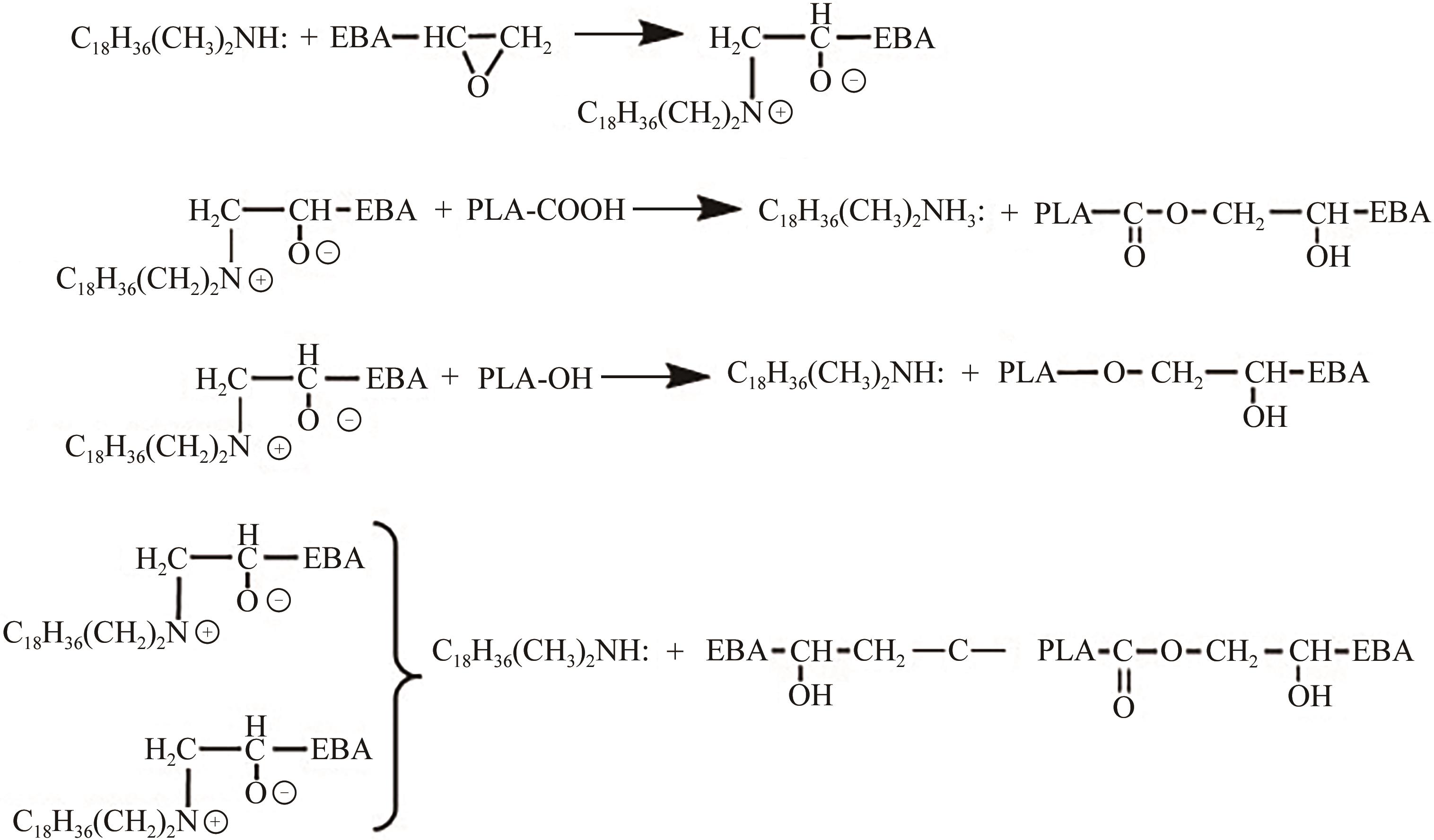
Chinese Journal of Applied Chemistry ›› 2024, Vol. 41 ›› Issue (4): 529-537.DOI: 10.19894/j.issn.1000-0518.230345
• Full Papers • Previous Articles Next Articles
Preparation and Properties of Highly Toughened Poly(lactic acid)/ Ethylene-Butyl Acrylate-Glycidyl Methacrylate Graft Copolymer Blends
Zheng ZHOU, Yi-Wei XIA, Jie JIN, Song-Qi ZHENG, Si-Yu ZHOU, Gui-Yan ZHAO( )
)
- School of Petrochemical Engineering,Liaoning Petrochemical University,Fushun 113001,China
-
Received:2023-11-02Accepted:2024-03-12Published:2024-04-01Online:2024-04-28 -
Contact:Gui-Yan ZHAO -
About author:gyzhao@lnpu.edu.cn
-
Supported by:the Scientific Research Fund of Liaoning Provincial Education Department(LJKMZ20220733)
CLC Number:
Cite this article
Zheng ZHOU, Yi-Wei XIA, Jie JIN, Song-Qi ZHENG, Si-Yu ZHOU, Gui-Yan ZHAO. Preparation and Properties of Highly Toughened Poly(lactic acid)/ Ethylene-Butyl Acrylate-Glycidyl Methacrylate Graft Copolymer Blends[J]. Chinese Journal of Applied Chemistry, 2024, 41(4): 529-537.
share this article
Add to citation manager EndNote|Ris|BibTeX
URL: http://yyhx.ciac.jl.cn/EN/10.19894/j.issn.1000-0518.230345
| Sample | w(DMSA)/% | Dn/μm | Impact strength/(kJ·m-2) |
|---|---|---|---|
| PLA/EBA-GMA(70/30) | 0 | 40.9 | 10.9 |
| 0.1 | 28.8 | 39.2 | |
| 0.2 | 12.7 | 44.9 | |
| 0.5 | 9.2 | 63.1 |
Table 1 Particle size of the dispersed phase in PLA/EBA-GMA/DMSA (70/30) blend system before and after DMSA addition
| Sample | w(DMSA)/% | Dn/μm | Impact strength/(kJ·m-2) |
|---|---|---|---|
| PLA/EBA-GMA(70/30) | 0 | 40.9 | 10.9 |
| 0.1 | 28.8 | 39.2 | |
| 0.2 | 12.7 | 44.9 | |
| 0.5 | 9.2 | 63.1 |
| Sample | w(DMSA)/% | Tg1/℃ | Tg2/℃ | ΔTg/℃ |
|---|---|---|---|---|
| PLA/EBA?GMA(70/30) | 0 | -44.1 | 66.9 | 111.0 |
| 0.1 | -38.7 | 65.8 | 104.5 | |
| 0.2 | -35.7 | 65.7 | 101.4 | |
| 0.3 | -32.7 | 66.0 | 98.7 | |
| 0.5 | -34.5 | 64.5 | 99.0 |
Table 2 Tg of each component in PLA/EBA-GMA (70/30) blends with different mass fraction of DMSA
| Sample | w(DMSA)/% | Tg1/℃ | Tg2/℃ | ΔTg/℃ |
|---|---|---|---|---|
| PLA/EBA?GMA(70/30) | 0 | -44.1 | 66.9 | 111.0 |
| 0.1 | -38.7 | 65.8 | 104.5 | |
| 0.2 | -35.7 | 65.7 | 101.4 | |
| 0.3 | -32.7 | 66.0 | 98.7 | |
| 0.5 | -34.5 | 64.5 | 99.0 |
| Samples | w(DMSA)/% | Tensile strength/MPa | Elongation at break/% | Tensile modulus/GPa |
|---|---|---|---|---|
| PLA | 76.3±0.7 | 8.8±0.0 | 2.1±0.2 | |
| PLA/EBA-GMA (70/30) | 0 | 32.5±0.5 | 20.7±1.0 | 1.3±0.1 |
| PLA/EBA-GMA (70/30) | 0.1 | 29.7±1.1 | 24.1±0.6 | 1.1±0.1 |
| PLA/EBA-GMA (70/30) | 0.2 | 24.5±1.0 | 17.5±1.3 | 0.9±0.1 |
| PLA/EBA-GMA (70/30) | 0.3 | 24.1±1.2 | 18.4±0.5 | 0.8±0.1 |
| PLA/EBA-GMA (70/30) | 0.5 | 19.6±1.4 | 21.4±1.9 | 0.5±0.2 |
Table 3 Tensile properties of PLA/EBA-GMA (70/30) blends with different mass fraction of DMSA
| Samples | w(DMSA)/% | Tensile strength/MPa | Elongation at break/% | Tensile modulus/GPa |
|---|---|---|---|---|
| PLA | 76.3±0.7 | 8.8±0.0 | 2.1±0.2 | |
| PLA/EBA-GMA (70/30) | 0 | 32.5±0.5 | 20.7±1.0 | 1.3±0.1 |
| PLA/EBA-GMA (70/30) | 0.1 | 29.7±1.1 | 24.1±0.6 | 1.1±0.1 |
| PLA/EBA-GMA (70/30) | 0.2 | 24.5±1.0 | 17.5±1.3 | 0.9±0.1 |
| PLA/EBA-GMA (70/30) | 0.3 | 24.1±1.2 | 18.4±0.5 | 0.8±0.1 |
| PLA/EBA-GMA (70/30) | 0.5 | 19.6±1.4 | 21.4±1.9 | 0.5±0.2 |
| 1 | GU T, ZHU D Y, LU Y, et al. Effect of PLA-g-GMA on the thermal, rheological and physical behavior of PLA/PBAT blends[J]. Polym Sci Ser A, 2019, 61(3): 317-324. |
| 2 | HAN Y, SHI J W, MAO L X, et al. Improvement of compatibility and mechanical performances of PLA/PBAT composites with epoxidized soybean oil as compatibilizer[J]. Ind Eng Chem Res, 2020, 59(50): 21779-21790. |
| 3 | 马轶莲, 胡浩东, 丁营利, 等. 羟基功能化离聚物与含环氧基团增容剂协同改性聚乳酸[J]. 应用化学, 2022, 39(12): 1870-1879. |
| MA Y L, HU H D, DING Y L, et al. Polylactic acid was co-modified by hydroxy-functionalized ionomer and epoxy-containing compatibilizer[J]. Chin J Appl Chem, 2022, 39(12): 1870-1879. | |
| 4 | LUYT A S, GASMI S. Influence of blending and blend morphology on the thermal properties and crystallization behaviour of PLA and PCL in PLA/PCL blends[J]. J Mater Sci, 2016, 51(9): 4670-4681. |
| 5 | 胡宽, 江海, 黄冬, 等. 聚丁二酸丁二醇酯与氯醚弹性体协同增韧改性聚乳酸多元共混体系[J]. 应用化学, 2019, 36(9): 996-1002. |
| HU K, JIANG H, HUANG D, et al. Polybutanediol succinate and chloroether elastomers were used to toughen poly(lactic acid) multicomponent blends[J]. Chin J Appl Chem, 2019, 36(9): 996-1002. | |
| 6 | LI J Q, XU M H, HE H Z, et al. Enhancing tensile strength and toughness via moderate orientation of amorphous molecular chains in biobased biodegradable poly(lactic acid)[J]. ACS Appl Polym Mater, 2022, 4: 6969-6977. |
| 7 | DAWIN T P, AHMADI Z, TAROMI F Z. Biocompatible PLA/PHB coatings obtained from controlled solid state polymerization[J]. Prog Org Coat, 2019, 132: 41-49. |
| 8 | ZHAO J C, WANG G L, CHAI J W J, et al. Polylactic acid/UV-crosslinked in-situ ethylene-propylene-diene terpolymer nanofibril composites with outstanding mechanical and foaming performance[J]. Chem Eng J, 2022, 447: 137509-137518. |
| 9 | JEONG J, AYYOOB M, KIM J H, et al. In situ formation of PLA-grafted alkoxysilanes for toughening a biodegradable PLA stereo complex thin film[J]. RSC Adv, 2019, 9: 24748-24759. |
| 10 | NIU W D, GUO Y F, HUANG W, et al. Aliphatic chains grafted cellulose nanocrystals with core-corona structures for efficient toughening of PLA composites[J]. Carbohydr Polym, 2022, 285: 119200-119210. |
| 11 | SU S, DUHME M, KOPITZKY R. Uncompatibilized PBAT/PLA blends: manufacturability, miscibility and properties[J]. Materials, 2020, 13(21): 4897-4914. |
| 12 | 李桂丽, 许京生, 冯巧, 等. 可降解塑料聚乳酸共混增韧改性进展[J]. 塑料, 2023, 52(5): 134-139. |
| LI G L, XU J S, FENG Q, et al. Progress in toughening modification of degradable plastic polylactic acid blend[J]. Plastics, 2023, 52(5): 134-139. | |
| 13 | WANG X, PENG S, CHEN H, et al. Mechanical properties, rheological behaviors, and phase morphologies of high-toughness PLA/PBAT blends by in-situ reactive compatibilization[J]. Composites, 2019, 173: 107028-107037. |
| 14 | SUI X Y, ZHAO X Y, WANG Z C, et al. Super-ductile and stiff PBAT/PLA biodegradable composites balanced with random PMMA-co-GMA copolymer as compatibilizer[J]. Soc Ind Chem, 2023; 72: 333-341. |
| 15 | DING Y, FENG W T, LU B, et al. PLA-PEG-PLA tri-block copolymers: effective compatibilizers for promotion of the interfacial structure and mechanical properties of PLA/PBAT blends[J]. Polymer, 2018, 146: 179-187. |
| 16 | KILIC N T, CAN B N, KODAL M, et al. The potential use of epoxy-POSS as a reactive hybrid compatibilizers for PLA/PBAT blends: “effect of PBAT molecular; weight and POSS type”[J]. Polym Eng Sci, 2020, 60(2): 25295-25311. |
| 17 | KILIC N T, CAN B N, KODAL M, et al. Compatibilization of PLA/PBAT blends by using epoxy-POSS[J]. J Appl Polym Sci, 2018, 00: 47217-47235. |
| 18 | FILHO E A D S, LUNA C B B, SIQUEIRA D D, et al. Tailoring poly(lactic acid) (PLA) properties: effect of the impact modifiers EE-g-GMA and POE-g-GMA[J]. Polymers, 2021, 14(1): 136-151. |
| 19 | DONG X, WU Z G, WANG Y, et al. Toughening polylactide using epoxy-functionalized core-shell starch nanoparticles-sciencedirect[J]. Polym Test, 2020, 93: 106926-106932. |
| 20 | XIA Y W, WANG G X, FENG Y L, et al. Highly toughened poly(lactic acid) blends prepared by reactive blending with a renewable poly(ether-block-amide) elastomer[J]. J Appl Polym Sci, 2021, 138(13): 50097-50107. |
| 21 | 夏艺玮. 高抗冲聚乳酸复合材料的制备与性能研究[D]. 抚顺: 辽宁石油化工大学, 2020. |
| XIA Y W. Preparation and properties of high impact polylactic acid composites[D]. Fushun: Liaoning Petrochemical University, 2020. | |
| 22 | SONG W J, LIU H Z, CHEN F, et al. Effects of ionomer characteristics on reactions and properties of poly(lactic acid) ternary blends prepared by reactive blending[J]. Polymer, 2012, 53: 2476-2485. |
| 23 | FENG Y L, ZHAO G Y, YIN J H, et al. Reactive compatibilization of high-impact poly(lactic acid)/ethylene copolymer blends catalyzed by N,N-dimethylstearylaminep[J]. Polym Int, 2014, 63(7): 1263-1269. |
| 24 | FANG C, LU X, QU J P, et al. Preparation and properties of biodegradable poly(lactic acid)/ethylene butyl acrylate glycidyl methacrylate blends via novel vane extruder[J]. Plast Rubber Compos, 2019, 48(8): 1-10. |
| [1] | Mei-Hua WANG, Yu FENG, Yun-Kun WANG, Xu-Dong ZHAO, Wen YANG, Chuan DONG. Preparation and Catalytic Performance of the Confined Pt Catalyst by Atomic Layer Deposition [J]. Chinese Journal of Applied Chemistry, 2024, 41(4): 547-556. |
| [2] | Xiu-Ying PENG, Xiao-Yan GAO, Song-Bai WANG, Fu LIU. Catalytic Decolorization Performance of Azo Dyes by Doped Nano-Nickel with Three-Dimensional Network Porous Structure [J]. Chinese Journal of Applied Chemistry, 2024, 41(4): 557-567. |
| [3] | Jing WANG, Xi-Lan LI, Xiu-Fen GUO. Preparation and Photocatalytic Properties of Niobium Pentoxide Photocatalyst [J]. Chinese Journal of Applied Chemistry, 2024, 41(3): 415-421. |
| [4] | Tian-Li SUN, Guo ZHU, Hai HE, Bing-Kun HUANG, Zhao-Kun XIONG, Bo LAI. Research Prospect of Single-Atom Catalysts for Fenton-Like Water Treatment [J]. Chinese Journal of Applied Chemistry, 2024, 41(2): 217-229. |
| [5] | Er-Gui LUO, Tao TANG, Yi WANG, Jun-Ming ZHANG, Yu-Hong CHANG, Tian-Jun HU, Jian-Feng JIA. Progress on Tuning the Geometric and Electronic Structure of Precious Metal Catalysts for Hydrogen Peroxide Production via Two-Electron Oxygen Reduction [J]. Chinese Journal of Applied Chemistry, 2023, 40(8): 1063-1076. |
| [6] | Yi-Ning DONG, He LI, Xue GONG, Ce HAN, Ping SONG, Wei-Lin XU. Research Progress of Non-Pt-Based Catalysts in Cathode Oxygen Reduction Reaction of Proton Exchange Membrane Fuel Cells [J]. Chinese Journal of Applied Chemistry, 2023, 40(8): 1077-1093. |
| [7] | Ying-Hua GUO, Shun-Fa ZHOU, Jing LI, Wei-Wei CAI. Research Progress in Regulation Strategy of Transition Metal Phosphate Catalyst for Electrochemical Water Splitting [J]. Chinese Journal of Applied Chemistry, 2023, 40(8): 1094-1108. |
| [8] | Yin-Nan QIAN, Chuan SHI, Wei ZHANG, Zhao-Yan LUO. Research Progress of Noble Metal Electrocatalysts for Oxygen Evolution Reaction in Acidic Environment [J]. Chinese Journal of Applied Chemistry, 2023, 40(8): 1126-1139. |
| [9] | Wei WANG, Jia-Yuan LI. Research Progress of Cobalt Phosphide Heterojunction Catalysts for Electrolytic Hydrogen Evolution Reaction [J]. Chinese Journal of Applied Chemistry, 2023, 40(8): 1175-1186. |
| [10] | Rui-Xue ZHENG, Qing-Lei MENG, Li ZHANG, Chang-Peng LIU, Wei XING, Mei-Ling XIAO. Hierarchically Porous Fe-N-C Catalysts for Efficient Electrocatalytic Oxygen Reduction Reaction [J]. Chinese Journal of Applied Chemistry, 2023, 40(8): 1187-1194. |
| [11] | Jia-Xin LIU, Jia-He FAN, Shu-Hui LI, Liang MA. Synthesis of Rh@Pt/C Concave Cubic Core-Shell Catalyst and Its Ethanol Electro-Oxidation Performance [J]. Chinese Journal of Applied Chemistry, 2023, 40(8): 1195-1204. |
| [12] | Yi-Cheng ZHANG, Fei ZHA, Xiao-Hua TANG, Yue CHANG, Hai-Feng TIAN, Xiao-Jun GUO. Research Progress of Heterogeneous Catalytic Preparation of Organic Peroxides [J]. Chinese Journal of Applied Chemistry, 2023, 40(6): 769-788. |
| [13] | Yi-Chen YU, Yu-Chen ZHANG, Yao-Yuan ZHANG, Qin WU, Da-Xin SHI, Kang-Cheng CHEN, Han-Sheng LI. Research Progress of Bulk Metal Oxides for Non-oxidative Propane Dehydrogenation [J]. Chinese Journal of Applied Chemistry, 2023, 40(6): 789-805. |
| [14] | Bing LI, Jun-Hui LIU, Ya-Kun SONG, Xiang LI, Xu-Ming GUO, Jian XIONG. Recent Advances in Application of Metal-Organic Frameworks for Hydrogen Generation by Catalytic Hydrolysis of Ammonia Borane [J]. Chinese Journal of Applied Chemistry, 2023, 40(3): 329-340. |
| [15] | Lu-Fei WANG, Meng-Meng ZHEN, Bo-Xiong SHEN. Research Progress of Controlling Lithium-Sulfur Batteries by Electrocatalysts under Lean Electrolyte Conditions [J]. Chinese Journal of Applied Chemistry, 2023, 40(2): 188-209. |
| Viewed | ||||||
|
Full text |
|
|||||
|
Abstract |
|
|||||
